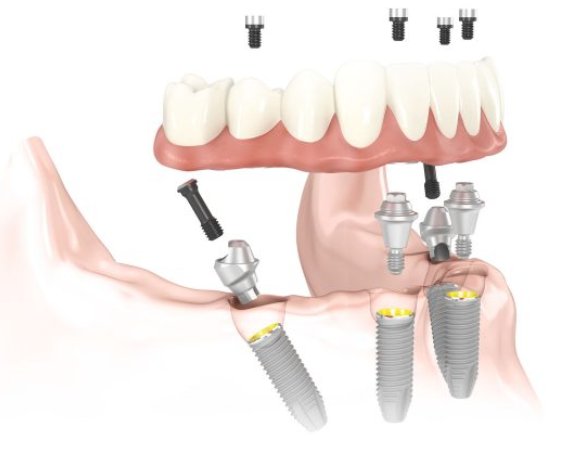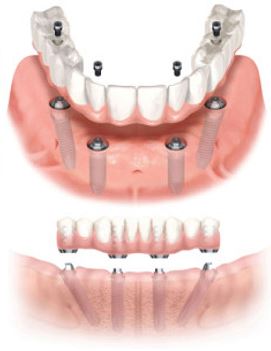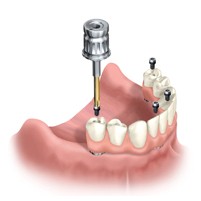All-on-4 Implant Dentures

What are All-on-4 Dental Implants?
The All-On-4 (All-On-Four) are a new dental implants technique originally developed in order to help edentulous patients with severe bone loss at the posterior areas of the jaw to get the benefits of implant supported dentures. All-on-6 and All-on-8 are variations of the same technique, but using a larger number of dental implants.
In this Article:
How All-on-4 Dental Implants Work?
The All-On-Four Dental Implants technique can offer the benefits of having implant supported bridges or dentures to patients who until now had no other option than the uncomfortable traditional dentures due to poor jaw bone condition not allowing the secure placement of standard implants.
 All-on-4 implants are often used for patients with severe jaw bone loss, too large or too low sinus cavities, or too shallow alveolar nerve in the lower jaw.
Although bone grafting is always recommended for patients with low jawbone quality,
those who can't afford the additional bone graft cost can now take advantage of the All-on-4 technique.
All-on-4 implants are often used for patients with severe jaw bone loss, too large or too low sinus cavities, or too shallow alveolar nerve in the lower jaw.
Although bone grafting is always recommended for patients with low jawbone quality,
those who can't afford the additional bone graft cost can now take advantage of the All-on-4 technique.
The All-on-4 technique requires the placement of only 4 implants, all in the anterior part of the jaw, where the jaw bone has usually the best density. In order to achieve better support the 2 implants towards the back of the jaw are placed at a high angle so that they can take advantage of the better bone quality at the front of jaw. With the all-on-4 design, the terminal abutments are tilted at a 30 degree angle from mesial to distal, thus extending the length of the metal framework that can be supported.
The All-on-4 procedure in summary includes:
- Diagnostic phase (x-rays / CT scan) to determine if All-on-4 implants are suitable.
- Preparation of a surgical template prior to dental surgery.
- Teeth extraction (if required) and dental implant post placement.
- Placement of the prosthetic restoration (bridge or overdenture of 12 to 14 teeth).
Benefits of All-on-4
 All-on-4 dental implants can provide the following advantages:
All-on-4 dental implants can provide the following advantages:
- They are a viable solution for patients with very poor bone condition.
- They are an alternative lower cost solution instead of bone grafting.
- Fewer implants can be used, lowering the cost of the overall treatment.
- In some cases, the immediate load technique can shorten treatment time.
- If immediate loading is possible, their placement can be completed in a single appointment.
How Much All-on-4 Dental Implants Cost?
The cost of All-On-4 dental implants can vary depending on the material used, the choice of dentist, and several other factors sa explained in detail in the relevant article about dental implants cost. The total cost will include:
- Initial consultation and treatment planning (usually free).
- CT scan / X-rays.
- Extraction of existing teeth (if needed).
- Bone grafting (if needed).
- Computer generated surgical guide (if required).
- Four dental implants and four abutments per jaw (material and placement).
- Temporary denture (if required, not needed in case of immediate loading).
- Final restoration, bridge or denture (made of acrylic, porcelaine, Zirconia etc).
The standard All-On-4 option involves using an acrylic denture built around a titanium framework. For this type of denture, it can cost between $15,000 and $30,000 per jaw. Dentures made of porcelain are more realistic looking and will last longer than acrylic, but the treatment could end up costing between $20,000 and $40,000 or more. Computer generated surgical guides can improve the surgical and restorative outcome but with an additional cost of $500-$1,500.
Considerations - Risks
Before you decide to take advantage of the all-on-four dental implants you should first consider some of the risks involved:
- Higher failure risk - The technique has been designed exclusively for patients with poor jawbone condition. A higher possibility of implant failure is expected in this high risk patient group.
- Combined failure risk - If one of the 4 supporting implants fails, the entire restoration fails and has to be reconstructed.
- Jaw fracture risk - Implants are placed only in the front jaw, therefore the jawbone deterioration continues at the posterior areas of the jaw increasing the risk of what is called a 'facial collapse'. If it becomes too weak, the jaw may fracture due to the pressure applied to the front part when eating.
A retrospective clinical study including 242 patients with 968 immediately loaded implants supporting fixed complete arch maxillary all-acrylic prosthesis demonstrated a high survival rate 93% at patient level and 98% at implant level after 5y of follow up. (Prosthodontic Perspective to All-On-4® Concept for Dental Implants)
What are All-on-6 / All-on-8
All-on-6 is just a variation of the all-on-four technique based on the same concept, with the only difference that 6 front implants are used instead of four. Many implant dentists prefer the 'all-on-6' option because it is safer (a restoration can be placed even if one of the six fixtures fails).
Another variation is the All-on-8 using 8 dental implants. Unlike the 'All-on-4' technique which uses acrylic dentures, 'All-on-8' uses dental bridges with crowns, which gives a more natural look to the teeth.
All-On-4 and their variations can help many patients who have limited amount of jaw bone and/or a limited budget. Decreasing the need for bone grafting can save a lot in healing time and treatment cost, but the higher risk of possible failures should also be considered.
next page -> How Much Do Dental Implants Cost (and Why)?



